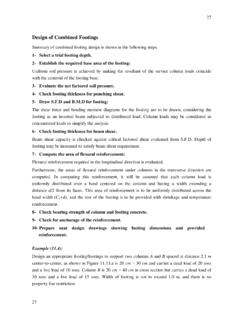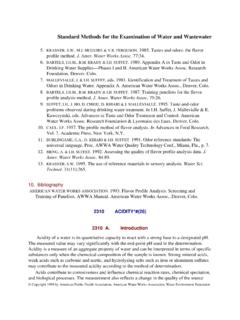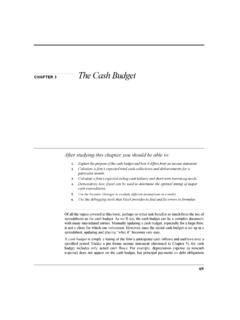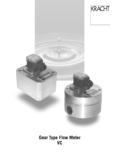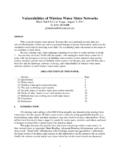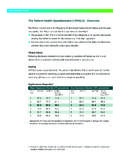Transcription of Wastewater FlowWastewater Flow Rate
1 Chapter-1Pf dSi AfifiProf. AfifiWastewater FlowWastewater Flow Rate Why we need to Measure Why we need to Measure Wastewater Flow? Why we need to Measure Wastewater Flow? Determining the rates of wastewaterflowis a fundamental step in the design ofttll titt tdwastewatercollection,treatment,anddisp osal facilities. In situation where wastewaterflow ratedata are limited orunavailable, wastewaterflow rate estimates have to be developedfttiddthfrom waterconsumption recordsandotherinformation. Why we need to Measure Wastewater Flow? Estimated residential flow rates need totftlbtkaccountfornotonly averages,butpeakflows. peak flows of short duration may ormaynothaveadeleteriousaffectmaynothave adeleteriousaffect,however peak flows that continue for Why we need to Measure Wastewater Flow?
2 ZTo develop a basis for properly assessingwastewaterflow rates fora community,they,following subjects should be considered. Definition of the various components thatmake up the Wastewater flow rates. Water supply data and its relationship towastewater flow rates. Wt tdflt Wastewater sources andflowrates. Analysis of flow rate data, and Mthdfdittflt Methodsofreducing wastewaterflowrates. COMPONENTS OF Wastewater FLOWSCOMPONENTS OF Wastewater FLOWSzThe components that make up thewastewater flow from a communityddhfllidependon thetypeofcollection systemused and may include the following: Domestic (also called sanitary) tdi hdfiddWastewaterdischargedfrom residences andfrom commercial, institutional, and similarfacilitiesfacilities.
3 Industrial Wastewater . Wastewater in whichindustrial COMPONENTS OF Wastewater FLOWSCOMPONENTS OF Wastewater flows Infiltration/Inflow (I/I).Water that enters thesewer system through indirect and directmeans. Infiltrationis extraneous (not directly connected)waterthatentersthesewersystemt hroughwaterthatentersthesewersystemthrou ghleaking joints, cracks and breaks, or porous walls. Inflowis storm water that enters the sewersystemfromstormdrainsconnectionroof systemfromstormdrainsconnection,rooflead ers, or through the manhole covers. Storm water. Runoff resultingfrom rainfallgand snowmelt. COMPONENTS OF Wastewater FLOWSCOMPONENTS OF Wastewater FLOWSzTherefore, Wastewater flows in sanitarysewersconsistsofthreemajorjcompo nents:(1)domestic Wastewater ,()(2) industrial Wastewater , and(3)infiltration/inflow.
4 ()ThepercentageofwastewatercomponentsThe percentageofwastewatercomponentsvaries with local conditions and the timeof ESTIMATING Wastewater FLOWRATES FROM WATER SUPPLY DATAzFor areas served with sewers, Wastewater flowrates are commonlydetermined from existingygrecords orbydirect field developments, wastewaterflow ratesare derived from an analysis of population dataandcorrespondingprojectedunitratesof waterandcorrespondingprojectedunitrateso fwaterconsumption or from estimates of per capitawastewaterflowratesfromsimilarcomm unities. ESTIMATING Wastewater FLOWRATES FROM WATER SUPPLY DATAzIf field measurements of wastewaterflow ratesare not possible and actual Wastewater flowratedataarenotavailablewatersupplyra tedataarenotavailable,watersupplyrecords can often be used as an aid toestimate wastewaterflow watersupplyrecords are not available,pp y,usefuldataforvarioustypesofestablishme nts and water-using devicesareprovidedformakingestimatesofwa stewaterprovidedformakingestimatesofwast ewaterflow rates.
5 Municipal Water UsezMunicipal water use is generally dividedintofourcategories:intofourcatego ries:. Dti(tdfitd Domestic(waterusedforsanitary andgeneral purposes) Industrial (nondomestic purposes). Municipal Water Use Public service (water used for firefightingsystemmaintenanceandfighting ,systemmaintenance,andmunicipal landscape irrigation). Unaccounted for system losses andleakageleakage. Domestic Water UseDomestic Water UsezDomestic water use encompasses the water suppliedto residentialareas, commercial districts, institutional facilities, and recreationalfacilities, , this water is put include drinking, washing, bathing, culinary(referring to cooking), waste removal and yard watering. Most ofthe water used in Palestinian municipal water supply system is fordomesticpurposesdomesticpurposes.)
6 Residential areas. Water used by residential householdsconsistsofwaterforinterioruses uchasshowersandtoiletsconsistsofwaterfor interiorusesuchasshowersandtoiletsand water forexterior usesuch as lawn (garden) watering andcar washing. Water use for exterior applications varies widelydependinguponthegeographiclocation ,climate,andtimeofdepe d gupotegeog ap cocat o ,cate,adteoyear and mainly consists of landscape irrigation. Domestic Water UseDomestic Water Use Commercial facilities. The water used by commercial facilitiesfor sanitary purposes will vary widely depending on the type ofactivity ( , an office as compared to a restaurant). For largefcommercial water-usingfacilities such as laundries and carwashes, careful estimates of actual water use should be made. Iii lf ili iWdbf ili ih suchashospitals, schools, and rest homes is usually based on somemeasure of the size of the facility and the type of housingfunctionprovided(egperstudentorpe rbed)functionprovided( ,perstudentorperbed).
7 Recreationalfacilities. Recreational facilities such asiildlbfidfswimming pools, camps, andclubs perform a wide rang offunctions involving water use. Typical distribution of residential interior waterUse% of ()11 Faucets (taps) Industrial (Nondomestic) Water Use zThe amount of watersupplied bymunicipalppypagenciestoindustriesforpr ocess(nondomestic)PrposesishighlariableB eca seind use varies widely,zItisthereforedesirableinpractica ldesignworkzItisthereforedesirableinprac ticaldesignworkto inspect the plant concerned and to makecareful estimates of the quantities of bothwaterused from all sources and the wastesproduced. Public Services and System Public Services and System Public Services and System Public Services and System Maintenance Maintenance Publicservicewaterrepresentsthesmallestc omponent of municipal water use.
8 Public service water uses include water used for publicbuildings, fire fighting, irrigating public parks andgreenbelts, ,andsystemmaintenance. System maintenance water uses include water fordisinfecting new water lines and storage reservoirs,lineandhydrantflushingandhydr aulicflushingoflineandhydrantflushing,an dhydraulicflushingofsewers. Only small amounts of water used for thesehthitttpurposes reachthesanitary sewersystem, exceptthat from public building. Unaccounted System Losses and LeakageygzUnaccounted system losses includeunauthorized use (Black Losses),incorrect meter calibration or readings,andimproper meter is due to system age, materials of construction, and lake ofsystem system losses and leakage may range from 10 to 12percentage of production for newer distribution systems (less than 25years old) and from 15 to 30 percent for older small water systems, unaccounted losses and leakage may account foras much as 50 percent of much as 40 to 60 percent of the unaccounted water may be attributedto meter , while water records may be useful in forecastingwastewater flow rates, the accuracy of the records must be checkedcarefullycarefully.
9 Estimating Water Consumption From Water Supply Estimating Water Consumption From Water Supply RecordszWater records of various types are kept by of water produced or withdrawn anddischarged to the water supply system and thetfttlld(d)amountofwateractuallyused(c onsumed).Thdi ti tiiittbtizThedistinctionisimportantbecau se more waterisproduced than is actually used by the consumer. Estimating Water Consumption From Water Supply Estimating Water Consumption From Water Supply RecordszThe difference between these two values is theamount of waterlost orunaccounted forin thedistribution system plus the amount used forvarious public services that may be ,inusingwatersupplyrecordstoestimate Wastewater flow rates, it is necessary todetermine the amount of wateractuallyused byyythe waterand losses do not reach thewastewater system and have to be excluded inmakingflowestimatesmakingflowestimates .
10 Factors Affecting Municipal Water UsezClimate. Climatic effects such as temperatureand precipitation can significantly peakwhenitishot and dry, due to largely to increased the average per capita water use but alsothe peak rate of use. The rate of use fluctuatesidillitiithoverawiderrangeinsm allcommunities withhigher peak flow (as compared to average use)andlowerminimumflowsandlowerminimumf lows. Factors Affecting Municipal Water UsezDensity of development. The density of development( ,condominiums,andapartments) ) homes may have more and apartments is generally much lessthan single-family homes because of reduced needs affluence or economic capabilities ofa community affects wateruse (and resultingwastewater flows ). As the assessed value of propertyincreases, so does wateruse and wastewaterflowrates.
